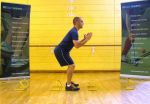Speed and agility is optional depending on your program. But all sports performers should look at including speed and agility in their training plans. Speed and agility is concerned with developing all areas of speed and agility development, linear and lateral, working on acceleration, deceleration and the ability to change direction, vital in all sports.
The basic drills are used to teach correct body position, knee drive and the finish position, simple speed skills and agility exercises are included. Stability (balance) in the end position should be addressed prior to pushing off / changing direction.
The core in the Sussexsport fitness training philosophy refers to not only the abdominal muscles, but the glutes, erector spinae, rectus and transverse abdominus and internal and external obliques. The core determines our posture aligning the spin, ribs and pelvis. If these areas are not aligned then we are likely to have a tilting of the pelvic girdle which will affect all movements. The core provides the base of support allowing us to exert force during knee dominant, hip dominant, vertical pull, horizontal pull, vertical push and horizontal push movements.
When working the core look at exercises that require isometric holds. Core exercises that require constant flexing and extending can place a great deal of stress on the lower spine. Research is also showing that the core is potentially designed to stop us extending backwards as opposed to flexing forwards, like in the crunch!
Poor posture can place huge amounts of stress through the spine. Consider this when are most people likely to show off out bad posture? Sitting at a desk? Now imagine someone sitting at their desk, but on their back, on the floor. Does this position look like a crunch exercise? Does the crunch not therefore reinforce bad posture?
 Plyometrics are a type of exercise designed to produce fast, powerful movements, and improve the functions of the nervous system, generally for the purpose of improving performance. Plyometric movements utilise the stretch shortening cycle (SSC), in which a muscle is loaded in the eccentric (lowering, muscle lengthening) phase and then contracted in rapid sequence (concentric, muscle shortens).
Plyometrics are a type of exercise designed to produce fast, powerful movements, and improve the functions of the nervous system, generally for the purpose of improving performance. Plyometric movements utilise the stretch shortening cycle (SSC), in which a muscle is loaded in the eccentric (lowering, muscle lengthening) phase and then contracted in rapid sequence (concentric, muscle shortens).
The progressions in the Sussexsport Fitness Training Philosophy follow a path where you get use to loading the muscle before you actually start to jump and land. This teaches the correct sequence for the SSC and primes the nervous system.
The body position should be chest up, hips back (slight lean forwards), feet in contact with the floor and knees in line with the shoulders (picture above). The start of the jump and finish of the landing should be the same position. If the hips drop lower on the landing than the take off, the intensity of the plyometric jump was greater than what you can handle. Remember the emphasis with plyometrics is quality, it is better to perform 3 decent jumps and stop than add 3 rubbish jumps.
Plyometric exercises come in many different forms. The progressions start with the most basic forms in Linear and Lateral / Medial plyometrics. Consider this the foundation, if you are unable to do these then by going straight into high intensity plyometrics is likely to cause yourself an injury. If you progress when you have learnt and mastered the basics then the next step into plyometrics will place less stress on your joints and tendons.
The main focus on any of the plyometric exercises is to:
- make sure the knees do not turn in or out
- quiet landings
- land on ball of foot then move back onto heels
- legs not straight, slight bend at the knees on landing
- hips back (slight lean forwards), feet contact with the floor and knees in line with the shoulders
Progressions on plyometrics should be double leg to single leg in the same session. The reason being in sports how often do performers land, jump or push off from two feet?
Power exercise should also be performed at the start of a session. These are a type of plyometric exercise mainly for the upper body and involve kettlebells and medicine balls.
Linear
| Level | Exercise |
|---|---|
| One | A March Single |
| Two | A March Double |
| Three | Falling Start |
| Four | Ball Release |
Lateral / Medial
| Level | Exercise |
|---|---|
| One | Lateral Acceleration Hold |
| Two | Lateral Acceleration Left Right Hold |
| Three | Lateral Acceleration Left Right Left |


